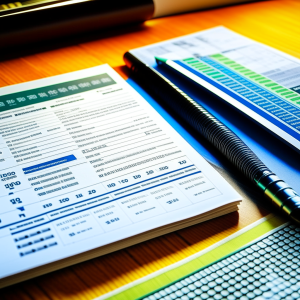Enhance Your Economic Preparedness: A Detailed Guide to Thriving Amid Financial Instability
In the current volatile economic landscape, it is crucial to gain a comprehensive understanding of economic collapse and its extensive repercussions. An economic collapse signifies a drastic failure of a country’s financial framework, leading to severe outcomes such as rampant unemployment, skyrocketing inflation, and a noticeable decline in living standards. As we navigate through these challenging times, it is imperative for individuals to prioritize strategies aimed at preparedness and resilience. By focusing on these essential strategies, individuals can effectively reduce the adverse effects of economic downturns, thereby enhancing their capacity to not only survive but thrive in the face of uncertainty and adversity.

Elevate Your Financial Preparedness for Long-Term Economic Stability
Building a Robust Emergency Fund: A Cornerstone of Financial Security
Establishing a solid emergency fund is a fundamental aspect of achieving financial resilience and security. This fund acts as a crucial financial safety net that protects individuals from unexpected challenges such as job loss, sudden medical expenses, or other unforeseen events. A well-funded emergency account can greatly alleviate financial strain, empowering individuals to navigate challenging situations without succumbing to overwhelming stress. By having a financial buffer in place, individuals can approach crises with confidence, ensuring stability and peace of mind during turbulent economic times.
Calculating the Ideal Size of Your Emergency Fund for Maximum Preparedness
Financial experts generally recommend maintaining an emergency fund that is equivalent to three to six months’ worth of living expenses. This guideline is intended to provide individuals with a sufficient financial cushion to effectively weather the storm during uncertain times. Such a buffer acknowledges the typical duration required to recover from setbacks like unemployment or unexpected expenses, facilitating a smoother transition back to financial stability. By carefully determining the size of your emergency fund, you proactively position yourself to take control of your financial future, even when facing unforeseen challenges.
Smart Strategies for Building Your Emergency Fund and Enhancing Financial Security
Identifying and Cutting Unnecessary Expenses: A thorough review of personal spending habits is often the first crucial step towards building a substantial emergency fund. This process involves distinguishing between essential needs and discretionary wants, thereby identifying specific areas where costs can be cut. By reducing unnecessary expenses and reallocating that income toward their emergency fund, individuals can gradually increase its size, significantly bolstering their overall financial security and resilience against economic fluctuations.
Boosting Income Through Side Hustles: A Strategic Move for Financial Stability: Actively seeking out additional income opportunities is a proactive approach that can greatly enhance financial resilience. Engaging in side hustles, part-time jobs, or freelance work allows individuals to channel extra earnings directly into their emergency fund. This strategy not only accelerates the fund’s growth but also creates diversified income streams, providing individuals with enhanced financial flexibility and security during uncertain economic times.
Setting Achievable Savings Goals: Your Blueprint for Financial Success: Establishing realistic savings targets is crucial for the successful development of an emergency fund. It is essential to create goals that align with your current financial situation and capabilities, which enables a sustainable and effective savings strategy. Regularly reviewing and adjusting these goals in light of changing circumstances can help maintain motivation and adaptability in reaching your financial objectives.
Ensuring Quick Access: Your Emergency Fund Must Be Readily Available When Needed
While it is vital to build a substantial emergency fund, ensuring that these funds are easily accessible is equally important. Choosing an account that allows for quick and penalty-free withdrawals is highly advisable. This accessibility guarantees that the emergency fund can be tapped into swiftly during critical moments, reducing stress and facilitating timely responses to unexpected challenges. Utilizing a dedicated savings account or a similar liquid asset can provide the necessary flexibility for effectively managing financial emergencies.
The Essential Importance of Debt Reduction in Your Financial Strategy
Reducing debt is a fundamental aspect of personal finance and plays a crucial role in achieving and maintaining financial stability. This need becomes particularly pressing for individuals managing high-interest debt, such as credit card balances. Addressing this financial burden is essential for anyone looking to secure a healthier financial future, as it lays the groundwork for long-term resilience and peace of mind during economic challenges.
Comprehending Your Debt Obligations: An Essential Step in Effective Financial Management
Before adopting debt reduction strategies, it is critical to understand the various types of debt one may encounter. Different categories of debt—such as credit card balances, student loans, and personal loans—possess unique attributes and implications. By gaining a clear understanding of the specific nature of these debts, individuals can devise a tailored and more effective debt reduction plan that aligns with their financial goals and enhances overall financial health.
Creating a Detailed Budget: Your Comprehensive Guide to Debt Reduction
 Developing a comprehensive budget serves as the backbone of any successful debt reduction strategy. This process requires a meticulous analysis of income sources alongside monthly expenses. By gaining clarity on financial inflows and outflows, individuals can pinpoint areas where they can save and allocate more funds toward debt repayment, ultimately facilitating quicker recovery and stability in their financial journey.
Developing a comprehensive budget serves as the backbone of any successful debt reduction strategy. This process requires a meticulous analysis of income sources alongside monthly expenses. By gaining clarity on financial inflows and outflows, individuals can pinpoint areas where they can save and allocate more funds toward debt repayment, ultimately facilitating quicker recovery and stability in their financial journey.
Debt Repayment Strategies: Choosing Between Snowball and Avalanche Methods for Optimal Results
Two popular debt repayment approaches are the snowball and avalanche methods. The snowball method aims to eliminate the smallest debts first, which can create a sense of achievement as each balance is paid off. Conversely, the avalanche method prioritizes clearing debts with the highest interest rates first, which ultimately saves money on interest payments over time. The choice between these strategies often depends on individual preferences, psychological factors, and personal financial aspirations.
Utilizing Professional Financial Advice: Enhancing Your Debt Management Strategy
For individuals facing complex debt situations or unique financial challenges, consulting a qualified financial advisor can be immensely beneficial. Financial advisors possess the expertise to assess individual circumstances, provide personalized solutions, and offer valuable insights. Their guidance extends beyond mere repayment plans, encompassing a holistic approach to financial planning that aligns with long-term financial objectives and aspirations.
Transforming Your Financial Mindset: Shifting from Short-Term Solutions to Sustainable Financial Strategies
Addressing debt involves more than simply repaying; it necessitates a shift in mindset towards nurturing long-term financial habits. This transformation requires individuals to reevaluate their spending practices, make informed decisions regarding credit utilization, and actively manage their financial resources. By approaching debt reduction as part of a broader financial journey, individuals can position themselves for lasting success in achieving their financial goals and improving their overall financial well-being.
Establishing Financial Resilience After Successfully Reducing Debt
Successfully reducing debt marks a significant achievement; however, it is crucial to leverage that momentum to ensure ongoing financial stability. Strengthening emergency funds, adopting a sustainable budgeting methodology, and making prudent investment choices are all vital components of this ongoing process. By reinforcing their financial foundation, individuals can mitigate the risk of falling back into debt and set the stage for a more secure financial future.
The Vital Role of Diversification in Crafting Smart Investment Strategies
In the ever-evolving landscape of investing, diversification serves as a key strategy for managing risks and maximizing returns. For investors aiming to navigate financial market complexities and safeguard their portfolios against economic fluctuations, understanding the intricacies of diversification is essential for achieving sustained success in their investment endeavors.
Grasping the Essentials of Diversification: Your Guide to Intelligent Investing
At its core, diversification involves distributing investments across a variety of asset classes, sectors, and geographical regions. This strategic allocation seeks to minimize the adverse effects of poor performance in any single investment, fostering a more balanced and resilient portfolio. The primary objective of diversification is to enhance the overall stability of the investment portfolio, thereby reducing its susceptibility to specific market downturns and fluctuations.
Strategic Asset Allocation: Diversifying Across Different Classes for Enhanced Security
Effective diversification requires a careful allocation of assets across various classes, each presenting distinct risk-return profiles. Investors typically allocate their capital across stocks, bonds, real estate, and alternative investments. This approach is based on the understanding that different assets react differently to economic events, enabling them to serve as a buffer against downturns in specific sectors or markets.
Managing Economic Volatility: The Protective Benefits of Diversification
A well-diversified portfolio acts as a financial safeguard, particularly during periods of economic uncertainty or market upheaval. While individual investments may experience fluctuations, the overall impact on the portfolio is generally mitigated due to this diversification approach. For instance, during economic downturns, bonds may remain stable while equities decline, providing a counterbalance that helps preserve the overall value of investments and enhances long-term financial security.
The Critical Role of Professional Insight in Developing Diversification Strategies
Successfully navigating the complexities of diversification requires a thorough understanding of financial markets, along with a clear perspective on risk tolerance and investment goals. Seeking guidance from financial advisors or investment specialists is vital when crafting a customized diversification strategy. These professionals can assist in optimizing portfolio allocation to meet specific financial objectives while providing insights into market trends and potential risks.
Staying Informed: Essential for Effective Market Awareness and Intelligent Investing
To ensure the efficacy of a diversification strategy, it is crucial to maintain a strong awareness of market dynamics and emerging trends. Regularly monitoring the financial landscape allows investors to make informed decisions about necessary portfolio adjustments. This vigilance involves staying updated on global economic indicators, geopolitical events, and industry-specific developments that could impact the performance of various asset classes and investment opportunities.
Embracing a Long-Term Perspective: The Pathway to Sustainable Investment Achievement
Diversification represents a long-term strategy that necessitates patience and discipline to endure short-term market fluctuations. Investors must resist the temptation to react impulsively to market changes and remain committed to their diversification plans. The ability of this strategy to withstand market fluctuations over time is the key determinant of its long-term success, ultimately aiding in the achievement of financial goals.
Implementing Effective Strategies for Comprehensive Economic Preparedness
Fortifying Household Resilience Against Economic Challenges
Strengthening household resilience against potential economic challenges becomes increasingly vital during times of instability or downturns. A proactive approach to preparedness entails stockpiling essential supplies, which is a crucial element of enhancing resilience. By diligently accumulating non-perishable food items, clean water, and hygiene products, households can create a buffer that enhances their capacity to endure economic difficulties, ensuring they are better prepared to tackle unforeseen circumstances and disruptions in their daily lives.
The Strategic Importance of a Well-Stocked Pantry for Effective Crisis Management
 A well-stocked pantry serves as a critical safety net for households, particularly in times when external factors may disrupt the availability or affordability of essential products. By proactively building and maintaining a reserve of necessities, families can shield themselves from supply chain interruptions or price volatility typically associated with economic downturns. This strategic preparation not only boosts food security but also provides peace of mind and confidence in managing potential crises.
A well-stocked pantry serves as a critical safety net for households, particularly in times when external factors may disrupt the availability or affordability of essential products. By proactively building and maintaining a reserve of necessities, families can shield themselves from supply chain interruptions or price volatility typically associated with economic downturns. This strategic preparation not only boosts food security but also provides peace of mind and confidence in managing potential crises.
Non-Perishable Food Items: Essential Planning for Sustained Stability
Non-perishable food items are essential components of a well-prepared pantry. Staples such as canned goods, grains, pasta, and dry foods offer extended shelf lives, ensuring sustenance during periods when fresh produce may be scarce or hard to acquire. Striking a balance between variety and practicality is key when selecting stocked items, as this allows households to meet their dietary preferences and nutritional needs while maintaining a reliable food supply to support overall well-being.
Water Reserves: A Vital Cornerstone of Preparedness
Although often overlooked, ensuring an adequate supply of clean water is paramount. Economic downturns can strain municipal resources and disrupt water infrastructure, making it essential to maintain a reserve of drinkable water. This proactive measure ensures that basic hydration needs are met, even during temporary interruptions to the regular water supply. By preparing for such scenarios, households can significantly bolster their resilience against adverse conditions and safeguard the well-being of their members.
Prioritizing Hygiene Products for Health and Well-Being During Economic Uncertainty
A comprehensive preparedness plan should encompass not only nutritional provisions but also a well-stocked supply of hygiene products. This includes personal care items, cleaning supplies, and toiletries. Ensuring that households are adequately equipped with these essentials helps maintain cleanliness and hygiene standards, contributing to overall health and well-being—especially critical during challenging times when access to these items may be limited.
Implementing Stock Rotation: Ensuring Freshness and Viability of Preparedness Supplies
Creating a well-stocked pantry is an ongoing endeavor that necessitates regular attention. Implementing a stock rotation system ensures that items remain fresh and suitable for consumption. This practice involves using and replacing stored products so that they do not spoil or expire. By adopting a systematic approach to rotation, individuals can maximize the effectiveness of their preparedness efforts while minimizing waste and ensuring readiness for any situation.
Gradual Accumulation: A Financially Savvy Method for Building Your Stock
There is no need to incur a significant financial burden all at once when building a stock of essential supplies. By adopting a gradual accumulation approach, individuals can allocate a portion of their budget to purchasing non-perishable items over time. This strategy alleviates immediate financial pressure while steadily constructing a durable pantry, allowing households to prepare without overwhelming their current financial situation while enhancing their overall security.
Cultivating Self-Sufficiency: Essential Skills for Daily Resilience
Developing self-sufficiency skills becomes increasingly vital during times of economic unpredictability or societal challenges. Enhancing practical abilities not only fosters a sense of empowerment but also equips individuals to navigate uncertainties with resilience. Skills such as gardening, basic home repairs, and food preservation are invaluable assets that can significantly diminish reliance on external resources, contributing to a more sustainable lifestyle and greater self-reliance.
Gardening: A Sustainable Source of Nutrition and Community Connection
 Embarking on a gardening journey transcends mere food production; it deepens the connection to the food cycle and the environment. By cultivating a garden, individuals not only gain access to fresh produce but also enhance their understanding of soil health, seasonal planting, and crop growth. This sustainable practice not only contributes to self-sufficiency but also enables individuals to share surplus food with their communities, fostering a culture of cooperation and support that strengthens community resilience.
Embarking on a gardening journey transcends mere food production; it deepens the connection to the food cycle and the environment. By cultivating a garden, individuals not only gain access to fresh produce but also enhance their understanding of soil health, seasonal planting, and crop growth. This sustainable practice not only contributes to self-sufficiency but also enables individuals to share surplus food with their communities, fostering a culture of cooperation and support that strengthens community resilience.
Mastering Basic Home Repairs: Empowering Independence in Daily Life
Acquiring basic home repair skills is a foundational aspect of self-sufficiency. Mastering the ability to troubleshoot common household issues and perform simple repairs can significantly lessen dependence on external services. This not only leads to cost savings but also instills a sense of competence and autonomy in managing one’s living environment. Individuals equipped with these skills can approach homemaking with confidence, tackling everything from minor leaks to electrical issues without unnecessary stress.
Food Preservation Techniques: Extending the Shelf Life of Your Resources
Understanding food preservation methods is an invaluable skill that aligns with self-sufficiency principles. Techniques such as canning, drying, fermenting, and freezing can extend the lifespan of food resources, reducing reliance on frequent grocery trips. Mastering these strategies not only stabilizes food supply but also minimizes waste by allowing individuals to capitalize on seasonal abundance and preserve surplus for future use. Community workshops and groups focused on food preservation offer valuable insights and a supportive environment for learning.
Community Engagement: Building Skills and Support Networks for Resilience
Active engagement in the community is essential for developing self-sufficiency skills. Participating in local clubs or workshops dedicated to gardening, home repairs, or food preservation presents unique opportunities to learn from others and foster mutual support. By sharing experiences and knowledge, individuals cultivate a sense of camaraderie that strengthens community ties. This collaborative spirit not only enhances personal skills but also builds a supportive network that proves invaluable during challenging times.
Fostering Community Bonds for Enhanced Resilience During Economic Challenges
Establishing strong community bonds is crucial for building resilience, particularly during periods of uncertainty and hardship. By nurturing relationships with neighbors and community members, individuals create a support network that can provide emotional, practical, and logistical assistance when needed. Engaging in local organizations or volunteer groups fosters deeper connections and reinforces the importance of community during trying times, ultimately enhancing collective resilience and strengthening a sense of belonging.
Creating a Supportive Social Fabric: The Importance of Connection in Building Resilience
The social fabric woven by community interactions serves as the foundation of resilience. Strong community ties foster a sense of belonging, creating an environment where individuals feel supported and interconnected. During crises, this shared identity becomes a powerful force, allowing communities to unite and address challenges collectively. Nurturing these connections through participation in community events and initiatives lays the groundwork for a resilient society capable of withstanding adversity.
Neighbors as Allies: Harnessing the Power of Local Relationships
Neighbors represent the immediate social circle that can significantly influence daily life and overall well-being. By fostering trust and cooperation among neighbors, individuals can transform mere proximity into a valuable source of support. Strong relationships with neighbors facilitate resource sharing and collaboration on community initiatives, contributing to a safer and more resilient living environment that benefits everyone involved.
Local Organizations: Creating Hubs of Unity and Support for the Community
 Engaging in local organizations strengthens community ties and offers a structured platform for
Engaging in local organizations strengthens community ties and offers a structured platform for
The Article Essential Strategies for Surviving a Collapsing Economy Was Found On https://limitsofstrategy.com


2 Responses
Your insights on economic preparedness resonate deeply, especially given the unpredictability we face today. I’ve found that building a robust emergency fund is just the starting point; it opens up the door to exploring other avenues of financial resilience. For example, diversifying income streams has become more important than ever. I recently started a side hustle that not only provides an additional safety net but also allows me to pursue my passions outside of my 9-5 job.
The exploration of economic preparedness is indeed timely and important. I particularly resonate with the emphasis on building a robust emergency fund as a cornerstone of financial security. From my own experience, having a safety net has not only provided me with peace of mind during uncertain times but has also empowered me to make decisions that align more closely with my values—like pursuing freelance work and supporting smaller local businesses rather than being tethered to a job for sheer survival.